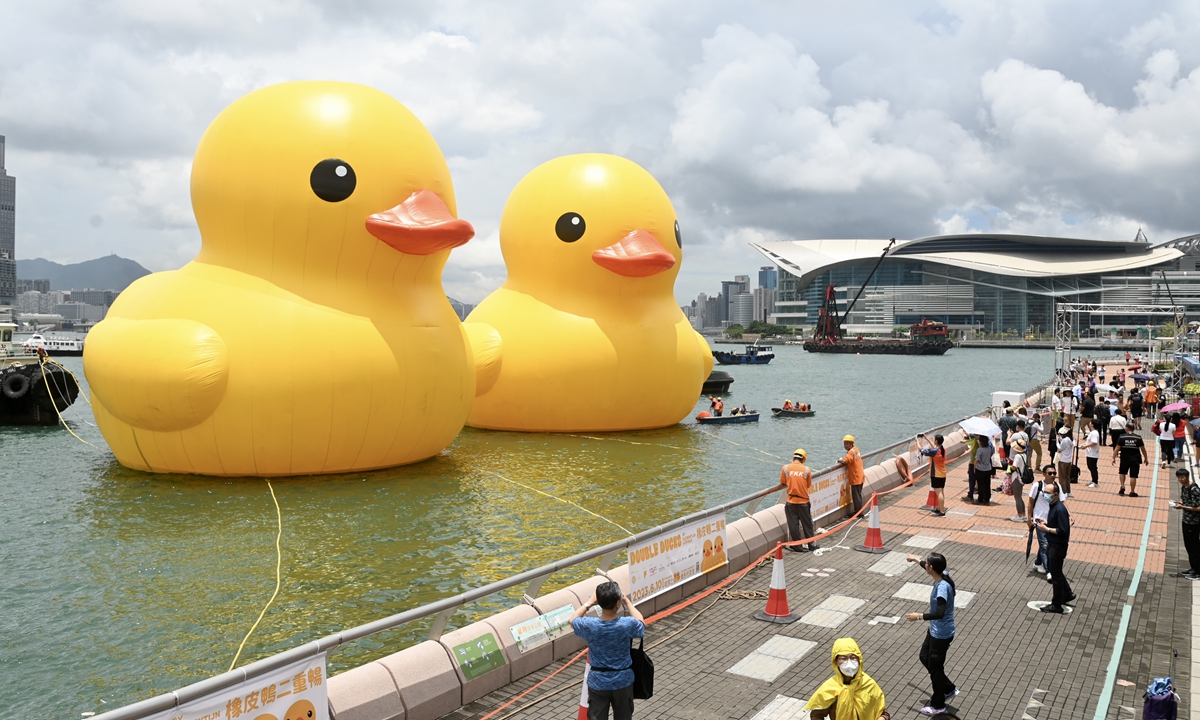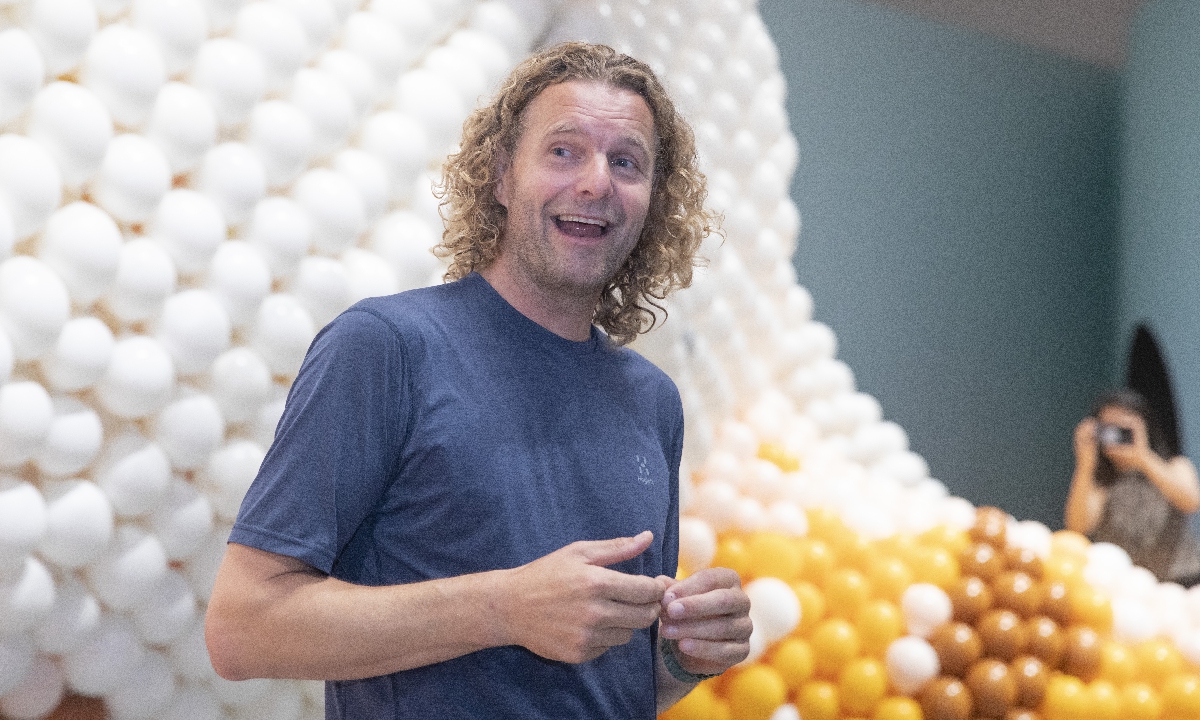ARTS / CULTURE & LEISURE
Rubber Duck creator reveals color secret and passion for making art in China
Chinese inspirations

A pair of giant rubber ducks float at Victoria Harbour in the Hong Kong Special Administrative Region. Photo: VCG
In Dutch artist Florentijn Hofman's art career, a photo captured in Kaohsiung City in the island of Taiwan distinctly stood out to him. It features Hofman's sculpture, the Rubber Duck placed in a public water feature much like a large pond, close to which an unexpectedly large crowd observed, with some staring while others took photos. Hofman's admiration for the photo speaks volumes.The picture and the crowds seen therein not only highlight the artist's most important piece that's brought him fame worldwide, but the resonance between the artwork and the ability of the common man to appreciate it, encapsulating Hofman's focus on making art accessible to everyday life as well as being a part of audiences from different cultural backgrounds just like the Celebrate Together!, Hofman's latest 2023 solo exhibition in Shanghai, China.
"I want to encourage people to communicate with each other and to feeling the joy of life. That's exactly why I want to hold an exhibition for Chinese audiences," Hofman said and to add that he had several new artworks made to have inspired by Chinese cultures.
'Birth' and 'youthfulness'
Having had his artworks previously showcased in several Chinese cities like Shenzhen and Chengdu, Southwest China's Sichuan Province, Hofman is a familiar figure to many, yet the current Shanghai show holds surprises for art lovers as it debuted 25 new works.
With the theme of celebration, Hofman told the Global Times that he hopes to bring Chinese audiences happiness, faith, and optimism, especially after the shared global experiences of the COVID-19 pandemic.
Inspired by Chinese zodiac culture, Hofam's Zodiac art series is only completed by the viewer's imaginative contribution. Twelve enlarged zodiac sculptures were set up, on which audiences could add decorations using colorful clay.
Hofman told the Global Times that he is much more relaxed about viewers' close interactions with his artworks, and prefers to showcase his work in open urban areas far more than in gallery spaces.
"It often excites me if audiences become a part of my project," Hofman noted.

Florentijn Hofman Photo: Courtesy of R+Production
Along with the famous Rubber Duck piece almost always bound to make an appearance at his exhibitions, Hofman has also created other playful pieces including Play Together, a 20-meter-long giant cat and mouse installation made up of balloons.The large-scale installation that is often exhibited above water has been showcased around the world in countries like China, the US, Australia, and Japan since it was first debuted in Amsterdam, Netherlands in 2007.
Hofman revealed during his interview with the Global Times that the duck sculpture's yellow color is the "color of new life" and symbolizes "birth" and "youthfulness."
Despite the squeaky rubber duck toy often being associated with bath time, Hofman's Rubber Duck design holds profound symbolism. Hofman told the Global Times that the "XL" size of the art installation, often as tall as18 meters, was designed to "season" public space occupied by "flat cold skyscrapers," and to eliminating human-art distance and "hierarchy."
Hofman's "duck of life" has also been showcased in China's Hong Kong Special Administrative Region twice, with the second showing coming after a 10-year hiatus.
The art piece, accompanied by the urban and social changes witnessed in Hong Kong over time, has made Hofman realize the power art holds as a catalyst that channels his updated reflections on profound subjects such as "vanity or the true self" and "technology's impact on reality."
"It wasn't a picture [the Rubber Duck in a public space] which you really had to look at twice," the artist noted, emphasizing how the value of his work is also tied to just how much it transforms the environment in which it is installed.
Wang Jiayi, the exhibition's curator and founder of R+ PRODUCTION, told the Global Times that Hoffman's work is popular in China due to its promotion through multi-media approaches such as the artist's "ostrich art" crossover collaborated with famous singer Chris Lee.
"Co-branding with coffee brands and interacting with users on social media platforms are all our attempts to spread Hofman's art through different channels," Wang noted.
Depth of the cuteness
Panda, Monkey, Kitten and Hippo… animals feature majorly as sources of inspiration in Hofman's work, many of which he created in China by studying local urban diversity and cultural tradition as inspirations.
Catering to the year 2022, also known as the Year of Tiger, Hofman took inspiration from China's classic tiger image, using 2 million balloons to create his Birthday Tiger.
Prior to that, a "Selfie Panda" was also put on display in Dujiangyan, a city close to Chengdu, southwest China's Sichuan Province, and the home of the giant panda.
The artist told the Global Times that different cities have their own "vibes," and Chinese cities' special characters add interesting "layers" to his artwork.
"I would drown myself into culture, observations, talking, eating and socializing," Hofman said and to add that accounts an important phase in creating new works.
Despite being labeled by many as the "duck artist," Hofman told the Global Times that his creative intention is not animal related, but the symbolic use of what's considered "dear to people," "cute," and "innocent" in order to connect to people. When one views an animal, one also reflects on his or her own behavior.
"One can indeed design various forms of art directly, but I like to use animals to euphemistically convey my ideas," the artist noted.
In Amersfoort, Hofman has created the "pissing polar bear" statue that "urinates" into the city's canal. The slight dead pan humor evident in the work was actually inspired by Hofman's reflections on environmental issues and humanity's imbalanced relationship with nature.
"If an artist expresses his ideas too directly, it loses the meaning," Hofman said.
